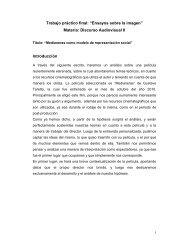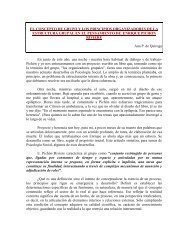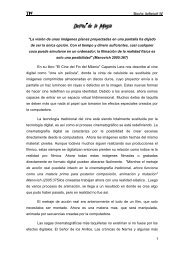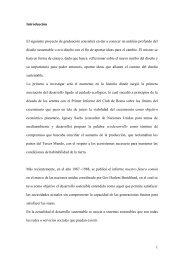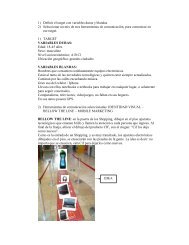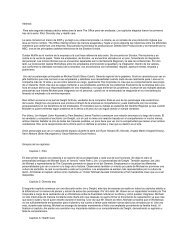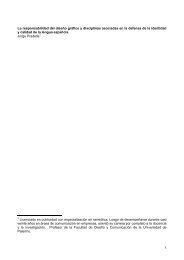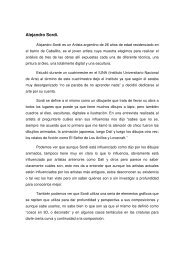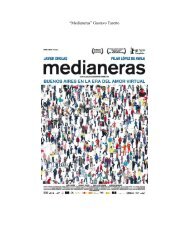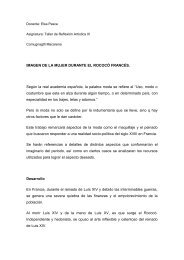Arte plumario en América Feather Art in America - Universidad de ...
Arte plumario en América Feather Art in America - Universidad de ...
Arte plumario en América Feather Art in America - Universidad de ...
You also want an ePaper? Increase the reach of your titles
YUMPU automatically turns print PDFs into web optimized ePapers that Google loves.
<strong><strong>Art</strong>e</strong> <strong>plumario</strong> <strong>en</strong> <strong>América</strong><br />
<strong>Feather</strong> <strong>Art</strong> <strong>in</strong> <strong>America</strong><br />
por / by Xim<strong>en</strong>a González Eliçabe *<br />
La pLuma ha sido <strong>de</strong>s<strong>de</strong> siempre un símboLo <strong>de</strong> Lo suave y etéreo,<br />
pero también <strong>de</strong> sabiduría, autoridad moraL y justicia.<br />
asociada a La div<strong>in</strong>idad y a La asc<strong>en</strong>sión ceLeste, La pLuma<br />
aparece <strong>en</strong> numerosos mitos aéreos <strong>de</strong>s<strong>de</strong> tiempos remotos.<br />
mito y simbolismo <strong>de</strong> la pluma<br />
En muchas ley<strong>en</strong>das los vestidos hechos con plumas confier<strong>en</strong><br />
la propiedad <strong>de</strong> volar a qui<strong>en</strong> los porta. Los personajes<br />
ataviados con plumas adquier<strong>en</strong> la div<strong>in</strong>idad <strong>de</strong> los pájaros<br />
y sus cualida<strong>de</strong>s <strong>de</strong> <strong>in</strong>gravi<strong>de</strong>z, <strong>de</strong> visión c<strong>en</strong>ital, <strong>de</strong> vuelo,<br />
que les otorgan a su vez elevación espiritual.<br />
El arte <strong>plumario</strong>, o plumaria, es una manifestación artística<br />
que se dio <strong>en</strong> difer<strong>en</strong>tes socieda<strong>de</strong>s <strong>de</strong> la antigüedad, <strong>en</strong><br />
diversos lugares <strong>de</strong>l mundo, como Asia, África, Oceanía y<br />
algunas islas <strong>de</strong>l Pacífico, pero fue <strong>en</strong> la <strong>América</strong> precolomb<strong>in</strong>a<br />
don<strong>de</strong> adquirió una mayor relevancia, a juzgar por las<br />
numerosas piezas halladas elaboradas con variadas técnicas<br />
<strong>de</strong> plumaria.<br />
Como era habitual <strong>en</strong> las culturas prehispánicas, el arte<br />
<strong>plumario</strong> estaba v<strong>in</strong>culado con el culto religioso, no t<strong>en</strong>ía<br />
simplem<strong>en</strong>te un f<strong>in</strong> estético. En las socieda<strong>de</strong>s <strong>en</strong> las que<br />
aún prevalece, como <strong>en</strong> algunos grupos étnicos <strong>de</strong>l Amazonas,<br />
a<strong>de</strong>más <strong>de</strong> su f<strong>in</strong> ritual, se utiliza para señalar las difer<strong>en</strong>cias<br />
sociales <strong>en</strong>tre los grupos. La pluma, como símbolo<br />
<strong>de</strong> prestigio y estatus social, sólo pue<strong>de</strong> ser usada por gue-<br />
<strong>Feather</strong>s have aLways be<strong>en</strong> symboLs oF Lightness and the<br />
ethereaL, but aLso oF wisdom, moraL authority and justice.<br />
associated with div<strong>in</strong>ity and the asc<strong>en</strong>sion to the heav<strong>en</strong>s,<br />
<strong>Feather</strong>s have appeared <strong>in</strong> numerous myths oF the skies<br />
s<strong>in</strong>ce time immemoriaL.<br />
<strong>Feather</strong>s, myth, and symbolism<br />
In many leg<strong>en</strong>ds, costumes ma<strong>de</strong> of feathers have conferred<br />
on their wearers the ability to fly. People dressed <strong>in</strong> feathers<br />
acquire the div<strong>in</strong>ity of birds, their properties of weightlessness,<br />
vision and flight, and also a certa<strong>in</strong> spirituality.<br />
<strong>Feather</strong> art is a form of artistic expression that emerged<br />
<strong>in</strong> many differ<strong>en</strong>t societies all over the anci<strong>en</strong>t world, <strong>in</strong><br />
Asia, Africa, Oceania and the Pacific islands. In terms of the<br />
number of pieces ma<strong>de</strong> with feather art techniques, however,<br />
it is <strong>in</strong> pre-Columb<strong>in</strong>e <strong>America</strong> where it acquired its<br />
greatest significance.<br />
In pre-Hispanic cultures, feather art was not just an aesthetic<br />
manifestation but an important elem<strong>en</strong>t of religious<br />
worship. What is more, <strong>in</strong> the societies where it has survived<br />
(for <strong>in</strong>stance, <strong>in</strong> certa<strong>in</strong> ethnic groups <strong>in</strong> the Amazon)<br />
<strong>in</strong> addition to its ritual purpose it is used to mark the social<br />
differ<strong>en</strong>ces betwe<strong>en</strong> groups. As symbols of prestige and social<br />
status, feathers may only be worn by warriors, nobles<br />
or priests.<br />
<strong>Feather</strong> costumes are used only on certa<strong>in</strong> occasions. In<br />
<strong><strong>Art</strong>e</strong> plumArio <strong>en</strong> AméricA 47<br />
<strong>Feather</strong> art <strong>in</strong> america
eros, nobles o sacerdotes, puesto que ost<strong>en</strong>ta autoridad y<br />
gran<strong>de</strong>za.<br />
Los trajes <strong>de</strong> plumas son usados solam<strong>en</strong>te <strong>en</strong> <strong>de</strong>term<strong>in</strong>adas<br />
ocasiones. En los ritos <strong>de</strong> pasaje y fertilidad el chamán<br />
<strong>en</strong>carna a seres sobr<strong>en</strong>aturales capaces <strong>de</strong> comunicar dist<strong>in</strong>tos<br />
estratos <strong>de</strong>l cosmos, el cielo y el <strong>in</strong>framundo; el traje<br />
es el vehículo que lo ayuda a atravesar ese espacio sagrado.<br />
En las danzas <strong>de</strong> carácter ritual los p<strong>en</strong>achos comunican<br />
relaciones simbólicas. En algunas manifestaciones folclóricas<br />
<strong>de</strong> Bolivia <strong>en</strong>contramos, <strong>in</strong>cluso actualm<strong>en</strong>te, varios<br />
ejemplos <strong>de</strong> ello. Así <strong>en</strong>tre los moxos los gran<strong>de</strong>s tocados<br />
cefálicos <strong>de</strong> plumas dispuestas radialm<strong>en</strong>te simbolizan el<br />
recorrido diario <strong>de</strong>l sol, <strong>de</strong>l naci<strong>en</strong>te al poni<strong>en</strong>te. También<br />
parec<strong>en</strong> <strong>in</strong>dicar la mitad <strong>de</strong>l año solar (el recorrido <strong>de</strong>l sol<br />
<strong>en</strong>tre los dos solsticios), repres<strong>en</strong>tado por unas 180 plumas;<br />
la cola que sale <strong>de</strong>l plumaje por la espalda simboliza al tigre<br />
o jaguar, animal sagrado relacionado con el sol. En la Puna<br />
arg<strong>en</strong>t<strong>in</strong>a, cada año se lleva a cabo un ritual s<strong>in</strong>crético, el día<br />
<strong>de</strong> la Asunción <strong>de</strong> la Virg<strong>en</strong>; <strong>en</strong> los pueblos <strong>de</strong> Casab<strong>in</strong>do e<br />
Iruya se realiza la danza <strong>de</strong> los smilantes, los hombres más<br />
prósperos, ataviados con plumas <strong>de</strong> suri bailan <strong>en</strong> una ceremonia<br />
propiciatoria, relacionada con la fecundidad <strong>de</strong> la<br />
tierra, con el cal<strong>en</strong>dario agrícola.<br />
La plumaria no sólo se usó <strong>en</strong> la vestim<strong>en</strong>ta y el adorno<br />
personal; <strong>en</strong> Mesoamérica y Sudamérica las pare<strong>de</strong>s <strong>de</strong> los<br />
templos se revistieron con tapices elaborados con plumas,<br />
se hicieron estandartes, escudos, flechas, abanicos, sombrillas,<br />
<strong>in</strong>strum<strong>en</strong>tos musicales y objetos <strong>de</strong> culto.<br />
Los objetos chamánicos hechos con plumas <strong>en</strong>cierran sabiduría<br />
y po<strong>de</strong>r a través <strong>de</strong> un conocimi<strong>en</strong>to cifrado. Cada<br />
48 Datatèxtil [ 23 ]<br />
fertility rites of passage, for example, the shaman embodies<br />
a supernatural be<strong>in</strong>g able to communicate with the differ<strong>en</strong>t<br />
strata of the cosmos, the heav<strong>en</strong>s and the un<strong>de</strong>rworld;<br />
his costume is the vehicle that <strong>en</strong>ables him to cross this sacred<br />
space. In ritual dances, the crests express symbolic relationships.<br />
In some folk manifestations <strong>in</strong> Bolivia we f<strong>in</strong>d<br />
various examples of this ev<strong>en</strong> today: for <strong>in</strong>stance, the great<br />
feather headdresses of the Moxos symbolize the journey of<br />
the sun from east to west. They also <strong>in</strong>dicate the middle<br />
of the solar year (the journey of the sun betwe<strong>en</strong> the two<br />
solstices), repres<strong>en</strong>ted by some 180 feathers; the tail that<br />
emerges from back of the plumage symbolizes the tiger or<br />
the jaguar, a sacred animal associated with the sun. In the<br />
Puna region <strong>in</strong> Arg<strong>en</strong>t<strong>in</strong>a, every year a syncretic ritual is<br />
held on the day of the Assumption of the Virg<strong>in</strong>, dressed <strong>in</strong><br />
suri feathers, the richest m<strong>en</strong> <strong>in</strong> the villages of Casab<strong>in</strong>do<br />
and Iruya take part <strong>in</strong> the dance of the similantes, a propitiatory<br />
ceremony for the fertility of the soil.<br />
<strong>Feather</strong> art was not used just <strong>in</strong> personal dress and<br />
adornm<strong>en</strong>t. In Mesoamerica and South <strong>America</strong> the walls<br />
of the temples were covered <strong>in</strong> tapestries ma<strong>de</strong> of feathers,<br />
and <strong>de</strong>corated with p<strong>en</strong>nants, standards, shields, arrows,<br />
fans, sha<strong>de</strong>s, musical <strong>in</strong>strum<strong>en</strong>ts and objects of worship.<br />
Shamanic objects ma<strong>de</strong> from feathers emanate wisdom<br />
and power through <strong>en</strong>co<strong>de</strong>d knowledge. With a narrative<br />
related to prayer, music, and dance, each one can be read<br />
like a text by the shaman. They do not repres<strong>en</strong>t the div<strong>in</strong>ity;<br />
they are the div<strong>in</strong>ity itself.<br />
uno <strong>de</strong> ellos pue<strong>de</strong> ser leído como un texto por el chamán,<br />
ti<strong>en</strong><strong>en</strong> una narrativa relacionada con la oración, la música<br />
y la danza. No repres<strong>en</strong>tan a la div<strong>in</strong>idad, son la div<strong>in</strong>idad<br />
misma.<br />
Desarrollo y producción<br />
En los An<strong>de</strong>s y sus regiones aledañas, se han registrado datos<br />
<strong>de</strong>l uso <strong>de</strong> las plumas asociado a la vestim<strong>en</strong>ta y los tocados<br />
<strong>de</strong>s<strong>de</strong> el año 3000 antes <strong>de</strong> Cristo. Estas piezas aparec<strong>en</strong><br />
tanto <strong>en</strong> las culturas <strong>de</strong> la selva (Tierras bajas, Yungas)<br />
don<strong>de</strong> no se conservan piezas arqueológicas, como <strong>en</strong> las<br />
sierras (culturas Arica, Tiahuanaco, Inca) o <strong>en</strong> la costa <strong>de</strong>l<br />
Pacífico (Paracas, Nazca, Chimú). Las técnicas <strong>de</strong>l arte <strong>plumario</strong><br />
se perfeccionaron <strong>en</strong>tre los siglos vii y xii, cuando se<br />
afianzó el comercio <strong>de</strong> estos valiosos materiales, que t<strong>en</strong>ían<br />
su orig<strong>en</strong> <strong>en</strong> la selva y se transportaban a través <strong>de</strong> gran<strong>de</strong>s<br />
distancias hasta la costa, don<strong>de</strong> se trabajaban como parte <strong>de</strong><br />
un arte textil exquisito.<br />
Una amplia red <strong>de</strong> producción e <strong>in</strong>tercambio comercial<br />
hizo posible el <strong>de</strong>sarrollo <strong>de</strong> este arte. Las técnicas o la aplicación<br />
<strong>en</strong> los dist<strong>in</strong>tos tipos <strong>de</strong> objetos que se producían<br />
variaban <strong>en</strong>tre una región y otra, pero la prefer<strong>en</strong>cia por las<br />
plumas exóticas y coloridas <strong>de</strong> la Amazonía fue una constante,<br />
que alim<strong>en</strong>tó este <strong>in</strong>tercambio. Se usaron plumas <strong>de</strong><br />
guacamayo, loro, tucán, colibrí, suri o ñandú, garza, azulejo,<br />
espátula rosada, águila, <strong>en</strong>tre otras aves. En México y<br />
Guatemala las plumas <strong>de</strong>l quetzal fueron las más preciadas<br />
y sagradas.<br />
Developm<strong>en</strong>t and production<br />
In the An<strong>de</strong>s and the surround<strong>in</strong>g regions, evid<strong>en</strong>ce of the<br />
use of feathers <strong>in</strong> garm<strong>en</strong>ts and headdresses has be<strong>en</strong> found<br />
dat<strong>in</strong>g back to 3000 BC. These samples appear both <strong>in</strong> the<br />
ra<strong>in</strong>forest cultures of the Yungas lowlands where there are<br />
no archaeological rema<strong>in</strong>s, among the Arica, Tiahuanaco<br />
and Inca cultures of the highlands, and <strong>in</strong> Paracas, Nazca,<br />
and Chimu on the Pacific coast. <strong>Feather</strong> art techniques<br />
emerged betwe<strong>en</strong> the sev<strong>en</strong>th and twelfth c<strong>en</strong>turies; these<br />
precious materials from the ra<strong>in</strong>forest were transported<br />
over great distances to the coast, where they became part of<br />
an exquisite textile art.<br />
A wi<strong>de</strong> network of production and trad<strong>in</strong>g helped the<br />
<strong>de</strong>velopm<strong>en</strong>t of feather art. The techniques or applications<br />
varied from region to region, but the prefer<strong>en</strong>ce for exotic,<br />
colourful feathers from Amazonia was a constant feature<br />
that fed this exchange. The art used feathers from all k<strong>in</strong>ds<br />
of birds: macaws, parrots, toucans, humm<strong>in</strong>gbirds, suris or<br />
rheas, herons, <strong>in</strong>digo bunt<strong>in</strong>gs, roseate spoonbills, and eagles.<br />
In Mexico and Guatemala the feathers of the quetzal<br />
were the most prized and the most sacred.<br />
The <strong>de</strong>gree of specialization atta<strong>in</strong>ed by feather art meant<br />
that feather workers <strong>en</strong>joyed consi<strong>de</strong>rable social esteem.<br />
In the Aztec city of T<strong>en</strong>ochtitlan, an area was giv<strong>en</strong> over<br />
to these artists, known as amantecas because they worked<br />
with amantla, the Aztec term for feathers. For their part the<br />
Incas recruited master feather weavers known as pillcocamayos<br />
from all over the Empire, who also <strong>en</strong>joyed special<br />
status at court. Some chronicles ev<strong>en</strong> report that there was<br />
<strong><strong>Art</strong>e</strong> plumArio <strong>en</strong> AméricA 49<br />
<strong>Feather</strong> art <strong>in</strong> america
50 Datatèxtil [ 23 ]<br />
El nivel <strong>de</strong> especialización que alcanzó el trabajo <strong>de</strong> las<br />
plumas hizo que los artistas que se <strong>de</strong>dicaban a ello fueran<br />
muy apreciados <strong>en</strong> su sociedad. En T<strong>en</strong>ochtitlán, los aztecas<br />
contaban con un barrio <strong>de</strong> artesanos que trabajaban las plumas,<br />
Amantla, y los plumajeros eran llamados amantecas.<br />
También los <strong>in</strong>cas reclutaban maestros tejedores <strong>de</strong> plumas,<br />
pillcocamayos, <strong>de</strong> los dist<strong>in</strong>tos puntos <strong>de</strong>l imperio, qui<strong>en</strong>es<br />
eran elevados a un estatus especial d<strong>en</strong>tro <strong>de</strong> su corte. Hay<br />
crónicas que <strong>de</strong>scrib<strong>en</strong> que había un <strong>en</strong>cargado <strong>de</strong> arreglar<br />
y mant<strong>en</strong>er los plumajes reales <strong>de</strong>l Inca. En aimara la palabra<br />
que se usa para <strong>de</strong>signar al tejedor <strong>de</strong> plumas es huayta<br />
camana; el l<strong>in</strong>güista Bertonio dice <strong>en</strong> su Vocabulario <strong>de</strong><br />
1612 que huayta significa «plumaje» o «flores».<br />
técnicas<br />
Las técnicas varían <strong>de</strong> acuerdo a la región, el tipo <strong>de</strong> plumas<br />
empleadas, el uso o valor simbólico que t<strong>en</strong>drá el objeto, y<br />
el período histórico-cultural al que pert<strong>en</strong>ec<strong>en</strong>. Básicam<strong>en</strong>te<br />
se divid<strong>en</strong> <strong>en</strong> dos tipos: las técnicas <strong>de</strong> <strong>en</strong>laces y las <strong>de</strong><br />
mosaico, admiti<strong>en</strong>do variantes y comb<strong>in</strong>aciones <strong>en</strong>tre ambos<br />
grupos. El primer grupo es <strong>de</strong> tipo estructural, y utiliza<br />
hilos y otras fibras vegetales, a m<strong>en</strong>udo comb<strong>in</strong>ados con<br />
técnicas <strong>de</strong> cestería; mi<strong>en</strong>tras que <strong>en</strong> el segundo grupo se<br />
trabaja sobre una superficie plana, como ma<strong>de</strong>ra, cortezas<br />
o p<strong>en</strong>cas.<br />
Así lo relatan las crónicas:<br />
«...Las telas <strong>de</strong> plumería eran <strong>de</strong> mayor estima y valor<br />
(que los cumbis y abasca)**, y con mucha razón; lábranlas<br />
<strong>en</strong> el mismo cumbi, pero <strong>de</strong> forma que sale la<br />
pluma sobre la lana y la <strong>en</strong>cubre al modo <strong>de</strong> terciopelo.<br />
El aparejo que t<strong>en</strong>ían para este género <strong>de</strong> telas era muy<br />
gran<strong>de</strong>, por la <strong>in</strong>numerable multitud y variedad <strong>de</strong> aves<br />
que cría esta tierra <strong>de</strong> tan f<strong>in</strong>os colores, que exce<strong>de</strong> todo<br />
<strong>en</strong>carecimi<strong>en</strong>to...<br />
...Aprobechábanse para esto <strong>de</strong> solas plumas muy pequeñas<br />
y sutiles, las cuales iban cogi<strong>en</strong>do <strong>en</strong> la trama con<br />
un <strong>de</strong>lgado hilo <strong>de</strong> lana y echándolas a un lado, haci<strong>en</strong>do<br />
<strong>de</strong> ellas mismas labores y figuras que llevaban sus más<br />
an official who arranged and looked after the Inca’s royal<br />
feathers. In Aymara the word used to d<strong>en</strong>ote the feather<br />
weaver was huayta camana; the l<strong>in</strong>guist Bertonio says <strong>in</strong> his<br />
«Vocabulary» dated 1612 that «huayta» meant plumage or<br />
flowers.<br />
techniques<br />
The techniques used varied accord<strong>in</strong>g to the region, the<br />
type of feathers used, the symbolic use or value of the object,<br />
and the historical or cultural period <strong>in</strong> question. Basically<br />
they are divi<strong>de</strong>d <strong>in</strong>to two types: b<strong>in</strong>d<strong>in</strong>g and mosaic,<br />
with variations and comb<strong>in</strong>ations betwe<strong>en</strong> the two groups.<br />
The b<strong>in</strong>d<strong>in</strong>g techniques used threads and other plant fibres,<br />
oft<strong>en</strong> comb<strong>in</strong>ed with basket weav<strong>in</strong>g methods; and <strong>in</strong> the<br />
mosaic techniques the work is done on a flat surface, like<br />
wood, bark, or leaves.<br />
As the chronicles say:<br />
«... the cloths of feathers were highly regar<strong>de</strong>d and<br />
had greater value (than the cumbis and abasca)**, and<br />
for good reason; they are ma<strong>de</strong> on the cumbi itself, but<br />
<strong>in</strong> such a way that the feather appears through the wool<br />
and covers it like velvet. The range of materials available<br />
for mak<strong>in</strong>g this k<strong>in</strong>d of cloth was vast, because of the <strong>in</strong>numerable<br />
multitu<strong>de</strong> and variety of birds that live <strong>in</strong> this<br />
land of such f<strong>in</strong>e colours …<br />
...They use for this very small, subtle feathers, which<br />
they take up <strong>in</strong> the weft with a th<strong>in</strong> wooll<strong>en</strong> thread and<br />
put them on one si<strong>de</strong>, mak<strong>in</strong>g out of them <strong>de</strong>signs and<br />
figures that were worn <strong>in</strong> their most beautiful cumbis.<br />
The spl<strong>en</strong>dour of these cloths of feathers were of such<br />
rare beauty that if one did not see them one can hardly<br />
imag<strong>in</strong>e them...». (Cobo, B. 1653)<br />
In the popular art of Mexico, many of these ancestral<br />
techniques <strong>en</strong>dure today. They were m<strong>en</strong>tioned by the first<br />
Spaniards to arrive: to quote Fray Bernard<strong>in</strong>o <strong>de</strong> Sahagun:<br />
«the first stage consists <strong>in</strong> attach<strong>in</strong>g the feathers with <strong>en</strong>grudo<br />
on the lower layer, f<strong>in</strong>ish<strong>in</strong>g the work thus... The second<br />
<strong><strong>Art</strong>e</strong> plumArio <strong>en</strong> AméricA 51<br />
<strong>Feather</strong> art <strong>in</strong> america
vistosos cumbis. El lustre y resplandor y visos <strong>de</strong> estas<br />
telas <strong>de</strong> pluma eran <strong>de</strong> tan rara hermosura, que si no es<br />
viéndolo, no se pue<strong>de</strong> dar a <strong>en</strong>t<strong>en</strong><strong>de</strong>r...». (Cobo, B. 1653)<br />
En el arte popular <strong>de</strong> México aún prevalec<strong>en</strong> muchas <strong>de</strong><br />
estas técnicas ancestrales, <strong>de</strong> las que hay registros tempranos.<br />
Según narra fray Bernard<strong>in</strong>o <strong>de</strong> Sahagún: «la primera<br />
manera <strong>de</strong> trabajar consiste <strong>en</strong> fijar las plumas con <strong>en</strong>grudo<br />
sobre la capa <strong>in</strong>terior, para term<strong>in</strong>ar así la obra... La segunda<br />
manera consiste <strong>en</strong> ejecutar el trabajo y darle f<strong>in</strong> con<br />
ayuda <strong>de</strong> hilo y bramante».<br />
El <strong>en</strong>grudo al que se refiere es un pegam<strong>en</strong>to natural a<br />
partir <strong>de</strong> la savia <strong>de</strong> una orquí<strong>de</strong>a. Esta manera <strong>de</strong> trabajar<br />
las plumas se usó sobre escudos y estandartes, también sobre<br />
p<strong>en</strong>cas <strong>de</strong> maguey, mas fue luego aprovechada por los<br />
misioneros cristianos, qui<strong>en</strong>es <strong>en</strong>com<strong>en</strong>daron a los <strong>in</strong>díg<strong>en</strong>as<br />
la elaboración <strong>de</strong> numerosas imág<strong>en</strong>es religiosas <strong>en</strong><br />
retablos y telas p<strong>in</strong>tadas al óleo, term<strong>in</strong>adas con mosaicos<br />
<strong>de</strong> plumas, que aún se conservan <strong>en</strong> iglesias y museos. En el<br />
sur <strong>de</strong>l cont<strong>in</strong><strong>en</strong>te americano esta técnica se usó para recubrir<br />
máscaras <strong>de</strong> ma<strong>de</strong>ra, o para confeccionar las chacanas,<br />
piezas cilíndricas <strong>de</strong> ma<strong>de</strong>ra, unidas y recubiertas por plumas<br />
que se usan cruzadas <strong>en</strong> bandolera sobre los hombros<br />
y el pecho <strong>de</strong> los bailar<strong>in</strong>es <strong>en</strong> la danza <strong>de</strong> Qu<strong>en</strong>a-qu<strong>en</strong>a, <strong>en</strong><br />
el actual <strong>de</strong>partam<strong>en</strong>to <strong>de</strong> La Paz, Bolivia.<br />
Para la realización <strong>de</strong> telas emplumadas, las técnicas estructurales<br />
podían ser dos: la primera <strong>en</strong>treteji<strong>en</strong>do las plumas<br />
preparadas <strong>en</strong> una <strong>de</strong>term<strong>in</strong>ada medida pero sueltas <strong>en</strong><br />
las pasadas <strong>de</strong> trama, ajustándolas con las sigui<strong>en</strong>tes pasadas<br />
<strong>de</strong> hilo, como se hace actualm<strong>en</strong>te <strong>en</strong> los huipiles (túni-<br />
52 Datatèxtil [ 23 ]<br />
consists <strong>in</strong> complet<strong>in</strong>g the work with the aid of thread and<br />
cord.»<br />
Engrudo is a natural paste ma<strong>de</strong> from orchid sap. This<br />
procedure was used to attach feathers to shields and standards<br />
or to agave leaves, and was later used by Christian missionaries<br />
who obliged the natives to create religious images<br />
for altarpieces and oil pa<strong>in</strong>ted cloths, f<strong>in</strong>ished with feather<br />
mosaics, which are still found today <strong>in</strong> churches and museums.<br />
Further south this technique was used to cover wood<strong>en</strong><br />
masks or to make chacanas, cyl<strong>in</strong>drical wood<strong>en</strong> frames,<br />
jo<strong>in</strong>ed together and covered by feathers and worn over the<br />
shoul<strong>de</strong>rs and chest. Chacanas are still worn today <strong>in</strong> La<br />
Paz, Bolivia, by performers of the Qu<strong>en</strong>a-qu<strong>en</strong>a dance.<br />
Two techniques were used to make feathered cloths. The<br />
first <strong>in</strong>volve <strong>in</strong>terweav<strong>in</strong>g feathers of a specific size but loose<br />
<strong>in</strong> the weft stitches, adjust<strong>in</strong>g them with the follow<strong>in</strong>g warp<br />
stitches, as is done today <strong>in</strong> the feathered tunics known as<br />
huipiles worn at wedd<strong>in</strong>gs <strong>in</strong> Z<strong>in</strong>ancantan <strong>in</strong> the south of<br />
Chiapas <strong>in</strong> Mexico. In the second method, the feathers are<br />
<strong>in</strong>terlaced on a ground thread; their stalks are tied <strong>in</strong> place<br />
with another horizontal thread and the feathers are th<strong>en</strong><br />
sewn on a base of pla<strong>in</strong> fabric, as <strong>in</strong> the tapestries of pre-<br />
Columb<strong>in</strong>e Peru. These techniques were also used to create<br />
the headdresses, and still survive today <strong>in</strong> Amazonia.<br />
To obta<strong>in</strong> the feathers, the area’s <strong>in</strong>habitants hunted <strong>in</strong><br />
the wild but also raised birds especially for the purpose.<br />
They ev<strong>en</strong> fed them with certa<strong>in</strong> k<strong>in</strong>ds of fruit or gra<strong>in</strong> that<br />
would alter the natural colours of the plumage. Another<br />
practice used for this purpose was known as tapiraje, which<br />
<strong>in</strong>volved rubb<strong>in</strong>g the sk<strong>in</strong> after the feathers had be<strong>en</strong> re-<br />
Eliscia si autat velit fugitatio<br />
conet es ratemped quist aut<br />
quibus, odiam laborep ernatius,<br />
sus, <strong>in</strong>t.<br />
Abore, nias eossed et officaturem<br />
vitatiaest faccae. Ture<br />
dolore por sum fugitae <strong>de</strong>l<br />
<strong>in</strong>torep elibus et omni<strong>en</strong>d ucillan<br />
d<strong>en</strong>diatest ab ipsan<strong>de</strong> lesci<strong>de</strong><br />
perores et ut qui occus.<br />
Lorum ut ad ma et etur, omnis<br />
ut pa qui voluptae nonsequiam<br />
rerchit at<strong>en</strong>dit facero quas utem<br />
qui ut eostiis id ull<strong>en</strong>ihitas si<br />
consequ oditio veliae conseru<br />
ptaepelit volorum fugiatemquis<br />
autet fugit quae. Et disciaerrum<br />
<strong>in</strong>ctatem sant ad ut veless<strong>in</strong>im<br />
aborio essime culparum fuga.<br />
Itasped ig<strong>en</strong>da sequundi am aut<br />
ese que aute <strong>de</strong>rrum consedit ea<br />
<strong><strong>Art</strong>e</strong> plumArio <strong>en</strong> AméricA 53<br />
<strong>Feather</strong> art <strong>in</strong> america
cas) emplumados <strong>de</strong> boda <strong>de</strong> Z<strong>in</strong>ancantán (Sur <strong>de</strong> Chiapas<br />
<strong>en</strong> México). La segunda, <strong>en</strong>trelazándolas sobre un hilo <strong>de</strong><br />
base, anudándolas <strong>de</strong>s<strong>de</strong> su raquis o tallo, sost<strong>en</strong>iéndolas<br />
con otro hilo horizontal y luego cosiéndolas sobre una base<br />
<strong>de</strong> tejido llano, como <strong>en</strong> los tapices <strong>de</strong>l Perú precolomb<strong>in</strong>o.<br />
Estas técnicas <strong>de</strong> <strong>en</strong>lace son también las que se usan para los<br />
tocados cefálicos, y aún se practican <strong>en</strong> el Amazonas.<br />
Para la obt<strong>en</strong>ción <strong>de</strong> las plumas no sólo se valían <strong>de</strong> la<br />
caza <strong>de</strong> animales silvestres, s<strong>in</strong>o que a<strong>de</strong>más criaban aves<br />
especialm<strong>en</strong>te con este f<strong>in</strong>. Incluso las alim<strong>en</strong>taban con<br />
<strong>de</strong>term<strong>in</strong>ados frutos o granos que hacían variar los colores<br />
naturales <strong>de</strong>l plumaje. Otra práctica utilizada con este f<strong>in</strong><br />
era la <strong>de</strong>l «tapiraje»; se lograba frotando la piel <strong>de</strong>splumada<br />
con secreciones <strong>de</strong> sapos y t<strong>in</strong>tes <strong>de</strong> plantas que daban<br />
coloraciones rojizas a las nuevas plumas. Por lo g<strong>en</strong>eral se<br />
esperaba la época <strong>de</strong> muda <strong>de</strong> plumas <strong>de</strong>l animal para su<br />
recolección.<br />
Si bi<strong>en</strong> el clima favorable <strong>de</strong> los An<strong>de</strong>s, con condiciones<br />
<strong>de</strong> baja humedad y temperaturas frías, ha posibilitado la<br />
conservación <strong>de</strong> piezas con materiales orgánicos tan frágiles<br />
como las plumas o los textiles, muchas <strong>de</strong> la cuales fueron<br />
halladas <strong>en</strong> tumbas o santuarios, se sabe que los <strong>in</strong>cas<br />
almac<strong>en</strong>aban cuidadosam<strong>en</strong>te las plumas con técnicas para<br />
evitar su <strong>de</strong>strucción, <strong>en</strong> <strong>de</strong>pósitos llamados collkas. Los<br />
cronistas españoles <strong>de</strong> la época dic<strong>en</strong>:<br />
«...<strong>en</strong>tre las <strong>de</strong>más cosas <strong>de</strong> que los españoles, cuando<br />
<strong>en</strong>traron hallaron <strong>en</strong> esta tierra, ll<strong>en</strong>os los <strong>de</strong>pósitos<br />
<strong>de</strong>l Inca, una <strong>de</strong> las más pr<strong>in</strong>cipales era gran cantidad <strong>de</strong><br />
pluma preciosa para estos tejidos: casi toda era tornasol<br />
con admirables visos, que parecían <strong>de</strong> oro muy f<strong>in</strong>o.»<br />
(Cobo, B. 1653).<br />
un arte que se <strong>de</strong>svanece<br />
Pocas manifestaciones <strong>de</strong> este arte vivo persist<strong>en</strong> hoy <strong>en</strong><br />
día, <strong>en</strong> algunas zonas <strong>de</strong>l Gran Chaco, <strong>de</strong>l Mato Grosso, <strong>de</strong>l<br />
Amazonas, <strong>de</strong> la sierra árida suband<strong>in</strong>a, <strong>de</strong> algunas regiones<br />
<strong>de</strong> México. Así como la selva tropical, <strong>de</strong>saparece, junto<br />
a la biodiversidad que se pier<strong>de</strong> con el supuesto progreso, la<br />
54 Datatèxtil [ 23 ]<br />
moved with secretions of toads and dyes from plants that<br />
gave a reddish colour to the new feathers. Usually, they<br />
waited until the birds shed their feathers to collect them.<br />
The favourable climate of the An<strong>de</strong>s, with their low humidity<br />
and cold temperatures, has allowed the preservation<br />
of fragile pieces like feathers and textiles, many of which<br />
were found <strong>in</strong> graves or sanctuaries. Nonetheless, we know<br />
that the Incas stored feathers with great care <strong>in</strong> or<strong>de</strong>r to<br />
prev<strong>en</strong>t their <strong>de</strong>struction, <strong>in</strong> <strong>de</strong>posits known as «collkas».<br />
Contemporary Spanish chroniclers recor<strong>de</strong>d that:<br />
«... among the other th<strong>in</strong>gs that the Spaniards found<br />
<strong>in</strong> the <strong>de</strong>posits of the Inca wh<strong>en</strong> they arrived <strong>in</strong> this land,<br />
one of the most important was the great quantity of<br />
beautiful feathers for these fabrics, which shone like the<br />
f<strong>in</strong>est gold.» (Cobo, B. 1653).<br />
An art that is disappear<strong>in</strong>g<br />
Few expressions of this art rema<strong>in</strong> alive today, <strong>in</strong> areas of the<br />
Gran Chaco, Mato Grosso, Amazonia, the dry highlands of<br />
the Sub-An<strong>de</strong>s, and some regions of Mexico. Like the ra<strong>in</strong>forest,<br />
it is disappear<strong>in</strong>g, along with the biodiversity, <strong>in</strong> the<br />
name of supposed progress, the expansion of the graz<strong>in</strong>g<br />
lands, the <strong>in</strong>discrim<strong>in</strong>ate fell<strong>in</strong>g of trees, and the <strong>in</strong>trusion<br />
of the garimpeiros <strong>in</strong> search of gold. With every day that<br />
passes, animals, plants, and cultures vanish without trace.<br />
<strong>Feather</strong> art is the expression of the <strong>de</strong>licate balance betwe<strong>en</strong><br />
nature, man, magic, and the universe of the subtle.<br />
The loss of traditional means of subsist<strong>en</strong>ce such as hunt<strong>in</strong>g<br />
and fish<strong>in</strong>g, and the acculturation and the evangelization of<br />
native populations, are all erod<strong>in</strong>g this ancestral wisdom.<br />
Perhaps this is the time to r<strong>en</strong>ew the cycle, as <strong>in</strong> the creation<br />
myth, to pay tribute to nature, and to re-establish harmony.<br />
The feather art of the <strong>America</strong>n peoples is a treasure<br />
that is slipp<strong>in</strong>g through our f<strong>in</strong>gers, the brilliant reflection<br />
of a world that could hardly have be<strong>en</strong> more noble and g<strong>en</strong>erous.<br />
expansión <strong>de</strong> las fronteras agropecuarias, la tala <strong>in</strong>discrim<strong>in</strong>ada<br />
<strong>de</strong>l monte nativo, la <strong>in</strong>trusión <strong>de</strong> los garimpeiros (buscadores<br />
<strong>de</strong> oro). Cada día que pasa hay animales, plantas y<br />
culturas que se <strong>de</strong>svanec<strong>en</strong>.<br />
El arte <strong>plumario</strong> es expresión <strong>de</strong>l <strong>de</strong>licado equilibrio <strong>en</strong>tre<br />
la naturaleza, el hombre, la magia, el universo <strong>de</strong> lo sutil.<br />
La pérdida <strong>de</strong> los recursos tradicionales <strong>de</strong> subsist<strong>en</strong>cia<br />
como la caza y la pesca, la fuerte aculturación <strong>de</strong> las poblaciones<br />
nativas, que <strong>en</strong> su mayoría han sido evangelizadas,<br />
contribuyeron al retroceso <strong>de</strong> su sabiduría ancestral, llevando<br />
<strong>en</strong> algunos casos a la persist<strong>en</strong>cia <strong>de</strong>l ornam<strong>en</strong>to vacío<br />
<strong>de</strong> significado o tergiversado.<br />
Quizá sea el mom<strong>en</strong>to <strong>de</strong> r<strong>en</strong>ovar el ciclo, como <strong>en</strong> el<br />
mito creador, r<strong>en</strong>dir tributo a la naturaleza, reestablecer la<br />
armonía. El arte <strong>plumario</strong> <strong>de</strong> los pueblos americanos es un<br />
tesoro que se escurre <strong>en</strong>tre nuestras manos, es un reflejo<br />
brillante y tornasolado <strong>de</strong> un mundo que podría haber sido<br />
más noble y g<strong>en</strong>eroso.<br />
notAs<br />
* La autora es diseñadora textil graduada <strong>en</strong> la <strong>Universidad</strong> <strong>de</strong><br />
Bu<strong>en</strong>os Aires. <strong>Art</strong>ista e <strong>in</strong>vestigadora <strong>de</strong> las tradiciones textiles<br />
americanas, es profesora universitaria. Ha realizado exposiciones<br />
y obtuvo premios con su actividad profesional.<br />
** cumbi: <strong>de</strong>l quechua, tejido f<strong>in</strong>o, <strong>de</strong> alta d<strong>en</strong>sidad e hilado<br />
<strong>de</strong>lgado, con faz <strong>de</strong> urdimbre.<br />
abasca/ ahuasca: <strong>de</strong>l quechua, tejido llano ord<strong>in</strong>ario, <strong>de</strong> baja<br />
d<strong>en</strong>sidad, con faz <strong>de</strong> trama.<br />
notes<br />
* The author is a textile <strong>de</strong>signer, a graduate of the. University<br />
lecturer, artist and researcher <strong>in</strong>to <strong>America</strong>n textile traditions. She<br />
has organized exhibitions and obta<strong>in</strong>ed prizes for her professional<br />
work.<br />
** cumbi: from the quechua: a f<strong>in</strong>e fabric, high d<strong>en</strong>sity and<br />
th<strong>in</strong>ly spun, with a warp face.<br />
abasca/ahuasca: from the quechua: ord<strong>in</strong>ary pla<strong>in</strong> fabric, low<br />
d<strong>en</strong>sity, with a weft face.<br />
<strong><strong>Art</strong>e</strong> plumArio <strong>en</strong> AméricA 55<br />
<strong>Feather</strong> art <strong>in</strong> america



